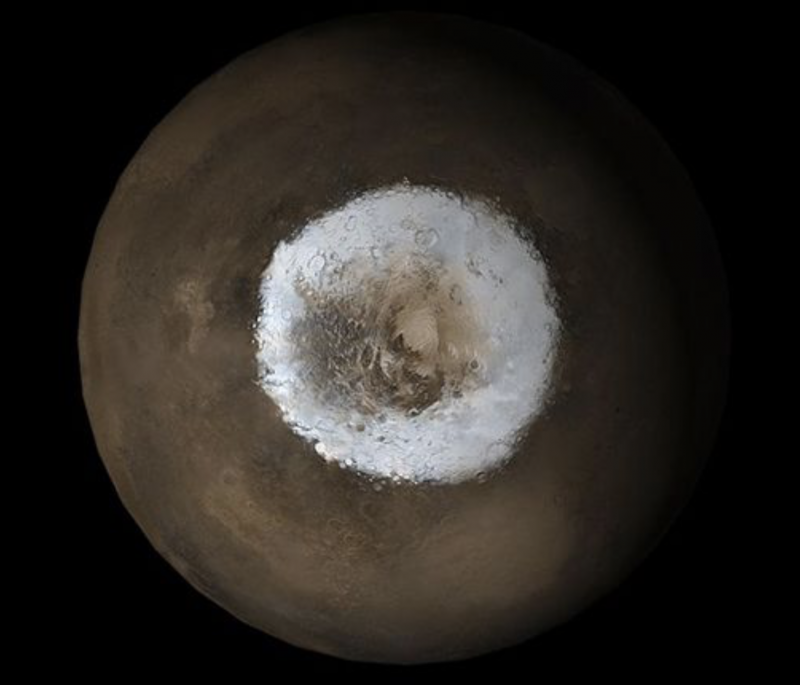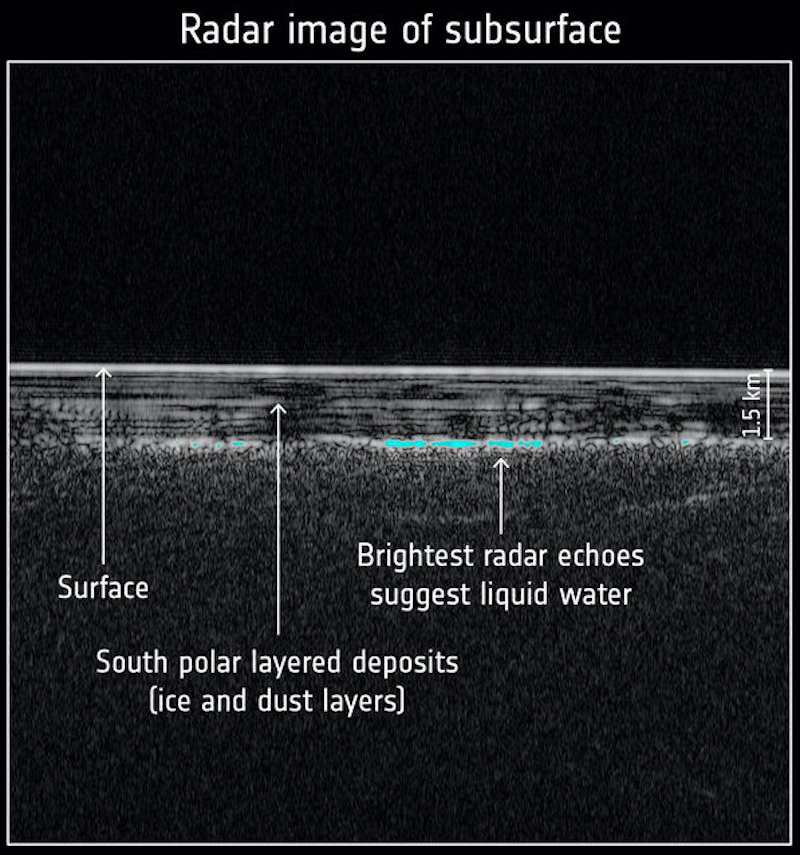
Is there liquid water on Mars? Earth’s southernmost continent, Antarctica, is thought to have hundreds of subglacial lakes beneath its ice. Some of those lakes might be liquid, thanks to the immense pressures below thick glaciers. There’s been tentative evidence for water beneath Mars’ polar ice caps, too, although not without controversy. Now an international team of scientists has new research that strengthens the case for possibly liquid lakes beneath Mars south pole.
The study – announced in late September, 2022 – uses data from NASA’s Mars Global Surveyor orbiter. The peer-reviewed findings were published in Nature Astronomy on September 29.
Liquid water on Mars?
Scientists first found possible evidence for liquid water beneath Mars’ south polar ice cap back in 2018. An exciting discovery, if true. Additional studies, though, cast doubt on the water interpretation. As the paper mentions:
Bright radar reflections observed in the Ultimi Scopuli region of Mars’ south polar layered deposits by the Mars Advanced Radar for Subsurface and Ionosphere Sounding instrument have been interpreted as the signature of areas of subglacial water beneath it. However, other studies put forward alternative explanations, which do not imply the presence of liquid water.
But now, with this new international study, the pendulum may swing back to the original water hypothesis. Previous interpretations – both pro and con – have been based primarily on radar data from the European Space Agency’s Mars Express orbiter. The new study, however, uses the Mars Orbiter Laser Altimeter measurements from Mars Global Surveyor of the shape of the upper surface of the ice cap. The measurements support the initial interpretation of the radar data. They provide the first independent line of data separate from the previous radar data. As lead author Neil Arnold, from the University of Cambridge’s Scott Polar Research Institute, noted:
The combination of the new topographic evidence, our computer model results, and the radar data make it much more likely that at least one area of subglacial liquid water exists on Mars today, and that Mars must still be geothermally active in order to keep the water beneath the ice cap liquid.
Frances Butcher from the University of Sheffield added:
This study gives the best indication yet that there is liquid water on Mars today. It means that two of the key pieces of evidence we would look for when searching for subglacial lakes on Earth have now been found on Mars.
Undulations beneath the surface
So, what did the new analysis show? The researchers looked at the surface topography of the polar ice cap in the same area where radar had detected the possible subsurface water. The Mars Global Surveyor data revealed an interesting undulation beneath the surface, about six to nine miles (10-15 km) long. The undulation consists of both a depression and a raised area. It deviates from the surrounding ice by several meters. Why is that significant? As the scientists note, they’ve seen similar undulations on Earth above subsurface glacial lakes.
So how do the scientists know the undulation was caused by liquid water and not something else? The researchers ran simulations of ice flow as they would occur on Mars. In addition, they added an area of “reduced bed friction” in the simulation. If there was water there, it would allow the ice to slide around it and speed up. Also, since the amount of geothermal heat coming from inside Mars isn’t known for certain, the researchers tweaked the simulation with various amounts of heat.

Simulated undulations a good match for the real ones
As it turns out, the simulated undulations are a good match for the real ones, similar in both size and shape. When these results are combined with the original radar data, it strengthens the case for liquid water being present beneath the ice cap. If so, how does the water stay liquid? It could be really salty, or, as the researchers suggest, subsurface magma may generate enough heat to do the job. Arnold said:
The quality of data coming back from Mars, from orbital satellites as well as from the landers, is such that we can use it to answer really difficult questions about conditions on, and even under the planet’s surface, using the same techniques we also use on Earth. It’s exciting to use these techniques to find out things about planets other than our own.
Liquid water on Mars and life
Is this proof of liquid water? Not quite, yet, but it is a compelling result that could lead to the discovery of other potential hidden bodies of water, as the paper notes:
These findings offer independent support for the presence of basal water beneath Ultimi Scopuli and suggest that surface topography could supplement radar returns to help identify other potential subglacial water bodies.
If the water is there, could it support life? Butcher said:
In order to be liquid at such cold temperatures, the water beneath the south pole might need to be really salty, which would make it difficult for any microbial life to inhabit it. However, it does give hope that there were more habitable environments in the past when the climate was less unforgiving.
Bottom line: Is there liquid water on Mars? A new international study supports the initial reported discovery in 2018 of water beneath Mars’ south polar ice cap. The study uses laser-altimeter data from NASA’s Mars Global Surveyor orbiter.
Source: Surface topographic impact of subglacial water beneath the south polar ice cap of Mars











